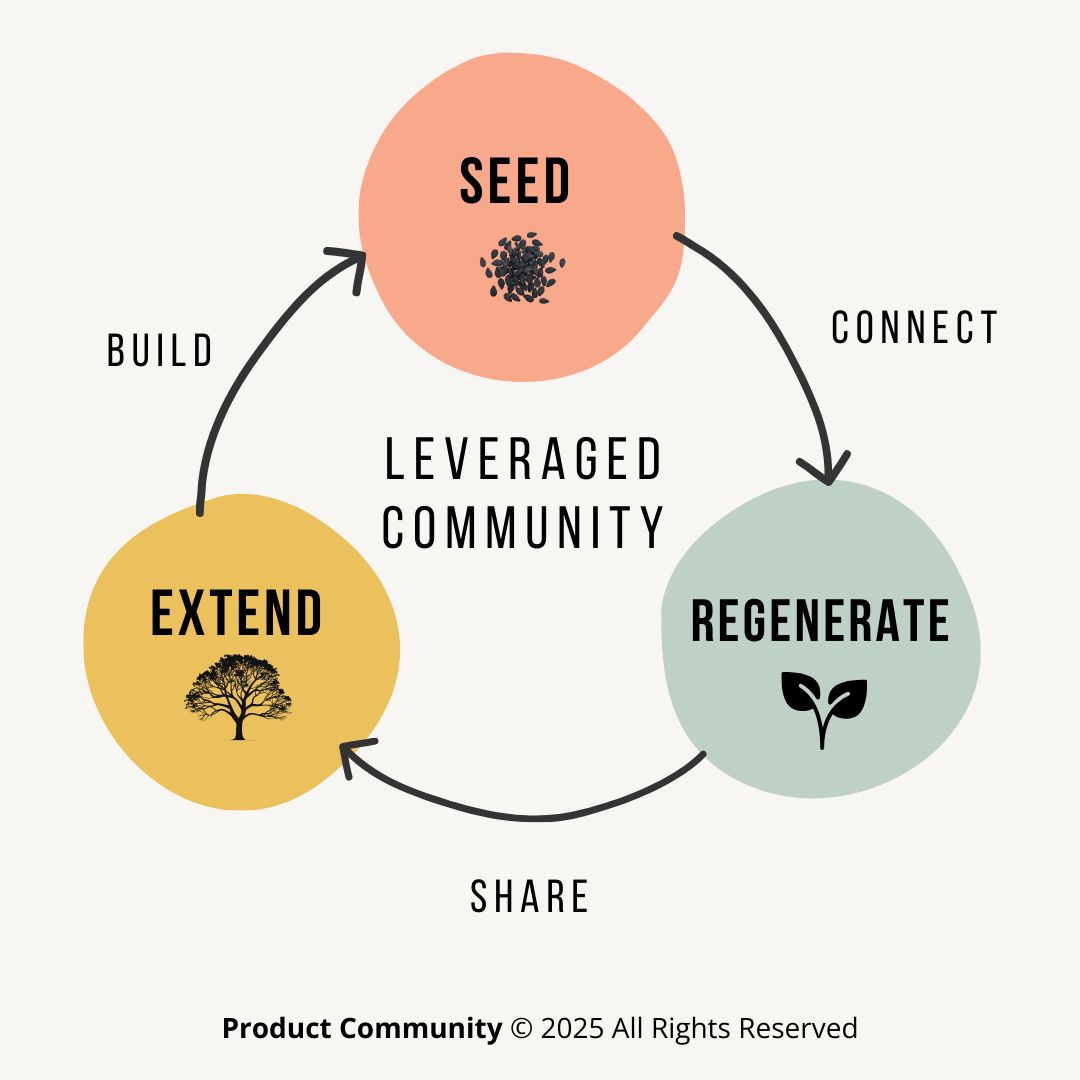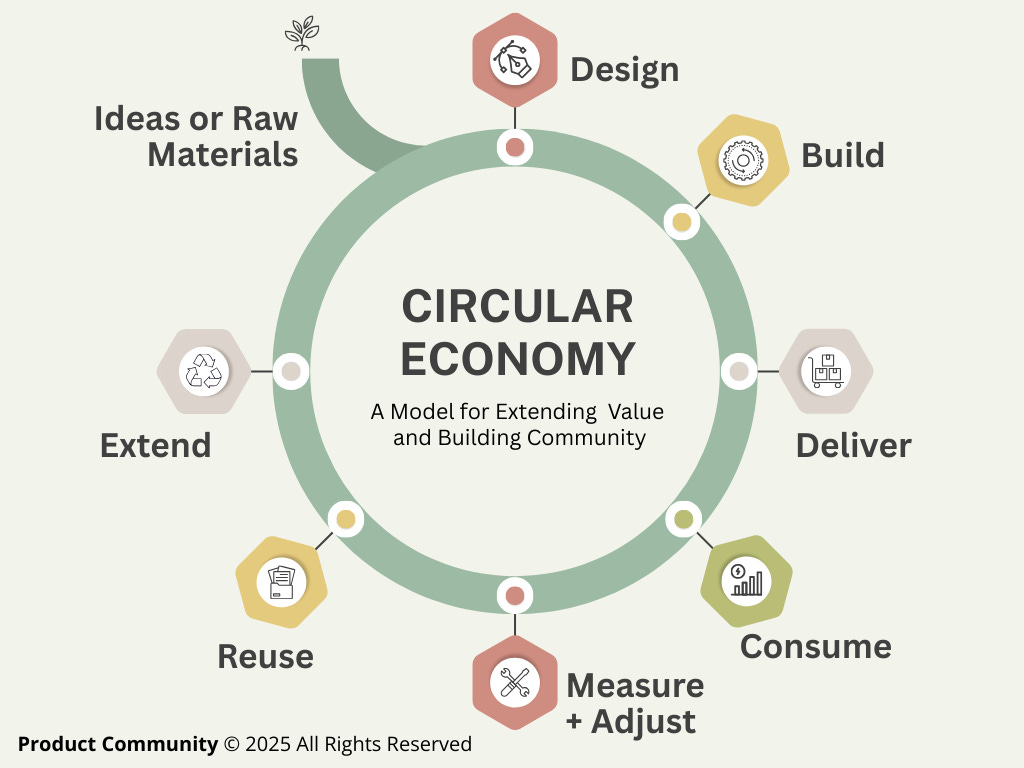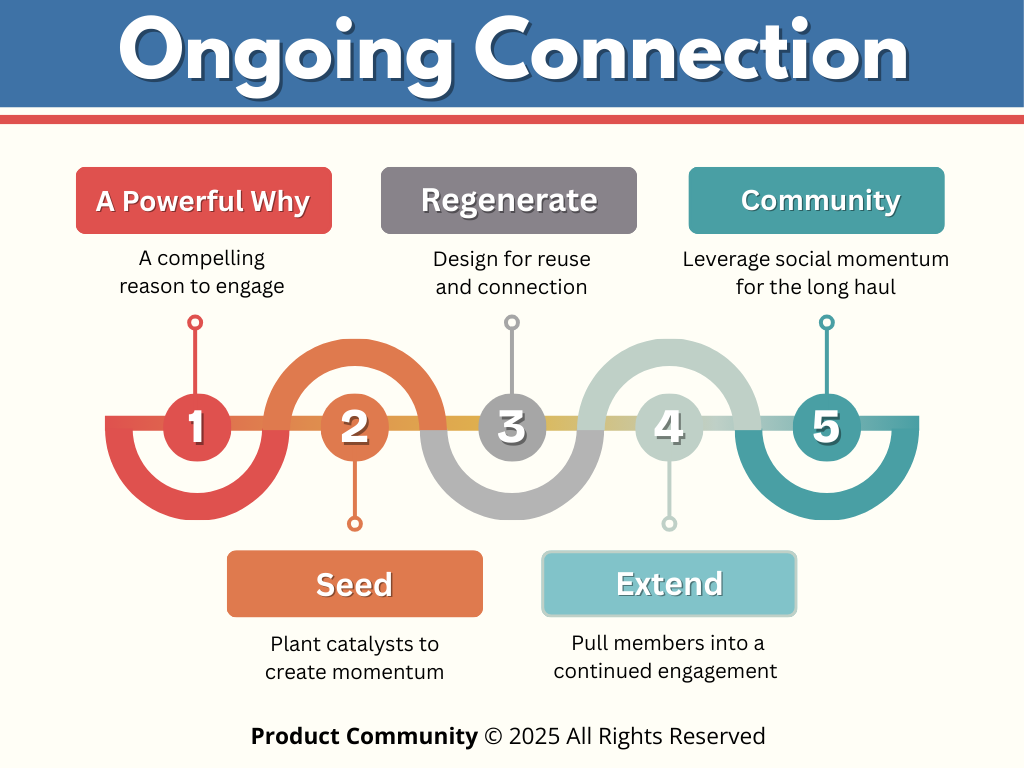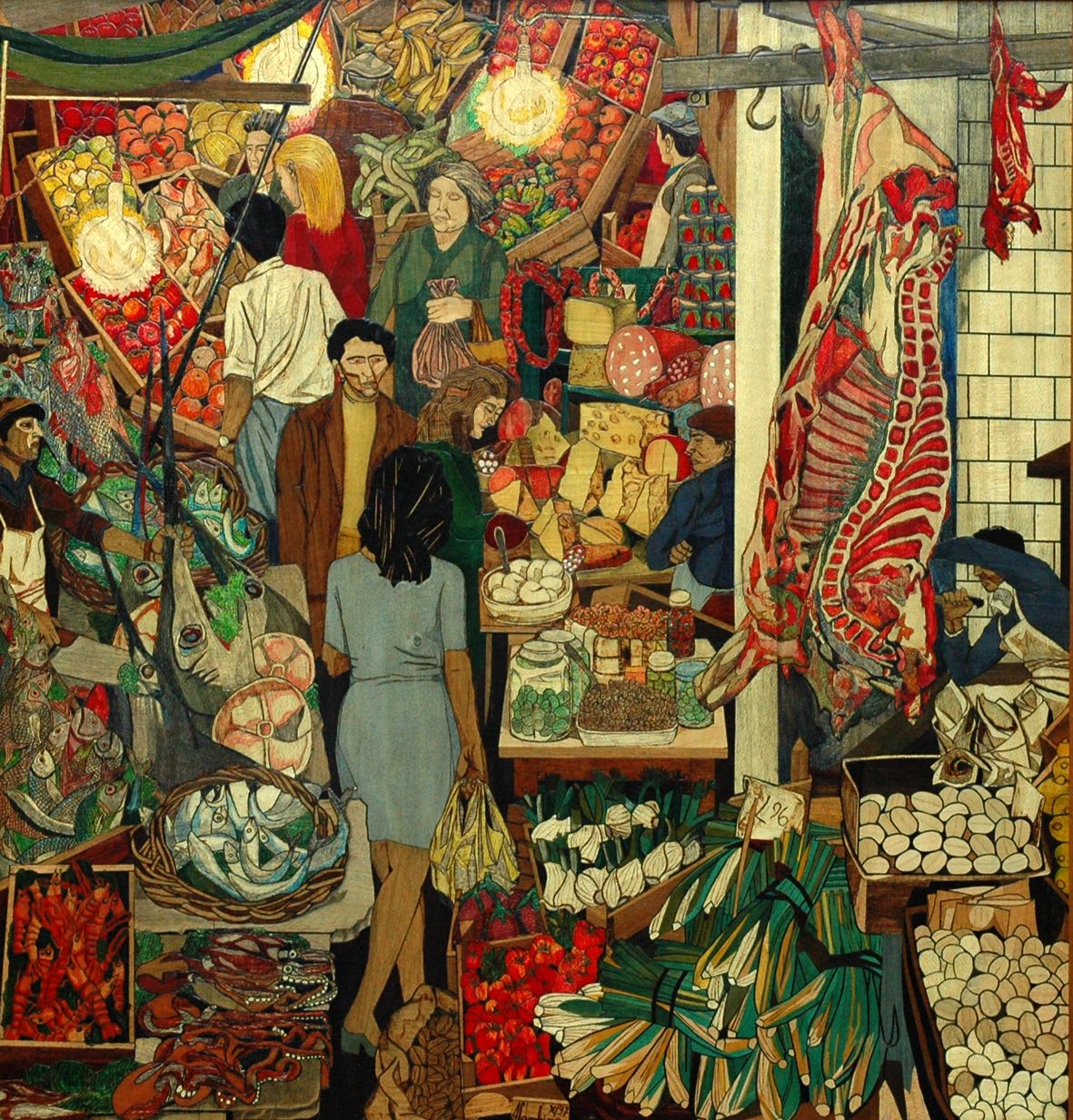The Continuous Member Journey
Maximizing Value to Create an Indispensable Community of Belonging | Lessons from the Circular Economy
Summary
Despite the many positives — connecting, engaging, learning — I find most association value to be hit-or-miss. This is an enormous opening to combat single-use one-and-done programming so we can focus more creatively on designing and implementing indispensable journeys of belonging.
This is an article about applying the circular economy to associations. The circular economy is based on the reuse and regeneration of materials or products as a means of sustainably providing value. For associations, this means doubling down on knowing our members so we create reusable systems to serve them meaningfully and compellingly over the long haul. The shared outcome is compounding value, keeping members durably connected.
I lead the product community, a product development learning community designed specifically for associations. Let’s compare ideas and build something great.
Indispensable Communities of Belonging
“What you people call your natural resources, our people call our relatives.”
Oren Lyons
A circular economy is like nature's recycling system: nothing gets wasted, everything has multiple uses, and each cycle makes the whole system stronger. Most organizations work like a straight line: take resources, make something, use it, throw it away. The circular economy works like a loop: design things to be reused, repurposed, and regenerated so they create value again and again.
Think about how a forest works. Fallen leaves become soil nutrients. Dead trees become homes for insects. Animal waste fertilizes new growth. Everything becomes input for something else; it all feeds back into the system to make it more vibrant and resilient. The same can be true for products, services, and experiences. They don't just get consumed once; they continue generating value through multiple life cycles.
For associations, these principles can transform episodic engagement into continuous belonging by creating regenerative relationships, connections that grow stronger each time members interact or engage with your community. This has implications for our portfolio offerings, our ideation efforts, how we think about the market, and, of course, how we engage and learn from our membership. Let’s expand on the idea by looking at a wealth of opportunities.
The Belonging Loop. Traditional associations can treat member engagement like a series of transactions: pay dues, attend events, consume content, repeat. Circular thinking creates belonging loops where each interaction deepens member investment in the community while simultaneously making them more valuable to other members. When a member shares expertise in a workshop, they're not just delivering content, they're becoming more embedded in the association's knowledge network. Other members benefit from their insights, but the presenter also gains deeper connections, enhanced reputation, and clearer understanding of community needs.
Mutual Value Creation. The most indispensable communities are those where members become more valuable to each other over time. Circular design facilitates this by creating multiple touch points where member expertise, experience, and networks can be shared and recombined. A member's career challenge becomes another member's case study opportunity. A chapter's successful program becomes a template for other regions. A retiree's institutional knowledge becomes mentoring content for emerging professionals. Each exchange doesn't deplete the original contributor, it enhances their standing and connections within the community.
Compound Belonging. Linear engagement treats each interaction as separate: attend a conference, take a course, read a publication. Circular engagement creates compound belonging where past participation makes future engagement more valuable and meaningful. Members who contribute to your research initiatives become invested in seeing how that research gets used. Those who mentor others develop deeper stakes in the community's future. People who help solve other members' problems become go-to resources who are sought out and valued. Each cycle of giving and receiving creates stronger emotional bonds to the community.
The Network Effect of Belonging. In circular systems, the more people participate, the more valuable participation becomes for everyone. This is the opposite of scarcity-based thinking where there's only so much opportunity to go around. When associations create regenerative systems — where member success stories become inspiration for others, where member innovations become community resources, where member connections facilitate other member opportunities — belonging becomes self-reinforcing. Members don't just benefit from what the association provides; they benefit from what other members create, and they're motivated to contribute because they see how their contributions matter.
Designing for Emotional Sustainability. The most powerful aspect of circular belonging is emotional sustainability. When members feel their contributions have lasting impact, when they see their expertise valued and built upon, when their participation creates opportunities for others, they develop what psychologists call meaningful membership. This goes beyond networking or professional development. It's the feeling that you're part of something larger than yourself, something that grows stronger because of your involvement. Members stop asking What can I get from this association? and start thinking How can I help this community thrive?
The transformation from consumer to co-creator is what makes our communities indispensable. Members can find content, training, and networking elsewhere. But they can't easily replace the deep sense of belonging that comes from being genuinely needed and valued as a contributor to something meaningful. When associations master circular belonging, they don't just retain members, they create advocates who can't imagine their professional lives without the community they've helped build.
How it Works in Practice
“Glance at the sun. See the moon and the stars. Gaze at the beauty of earth’s greenings. Now, think.”
Hildegard von Bingen
A circular economy approach to programming can create compound value by designing for reuse, regeneration, and continuous improvement. Here are some principles and practical implementation strategies. These core principles — modularity, multiple uses, feedback loops — serve as a basis for how to design your membership experience so can extend personalized value for individuals, teams, or diverse market segments.
Design for longevity and modularity Structure your content assets as modular components that can be easily updated, repurposed, and combined. For example, create educational modules on core competencies that can serve as standalone webinars, components of certification programs, or elements in annual conference sessions. This prevents the typical scenario where a great presentation gets used once and forgotten.
Cascade value through multiple uses Design a hierarchy where content moves through different applications as it ages. A cutting-edge research report might first serve as a premium member benefit, then become conference content, later transform into continuing education modules, and eventually become foundational material for newer members or students.
Trigger regenerative feedback loops Build mechanisms to capture insights from each use of content that improve future iterations. When members engage with a professional development program, their questions and outcomes should feed back into refining not just that program, but informing the design of related offerings.
Practical Implementation Strategies. Principles without investment makes it hard to design and execute on a circular approach to programming and community. These areas of investment suggest new capabilities afforded by new technologies, training, or system development.
Content Asset Management Develop a taxonomy that tags content by topic, audience level, format flexibility, and update requirements. This enables you to quickly identify which existing assets can be refreshed or repurposed for new initiatives rather than creating from scratch.
Cross-Platform Programming Design signature programs that can exist across multiple touch points. For instance, a leadership development initiative might include online modules, peer mentoring circles, conference sessions, and follow-up coaching opportunities, all drawing from and contributing to the same knowledge base.
Member-Generated Content Loops Create systems where member expertise becomes association content, which then educates other members who contribute their own insights. Case study competitions, best practice sharing, and peer-led sessions exemplify this regenerative approach.
Gauging progress. Measuring circular value is different from measuring membership counts, satisfaction scores, or traditional engagement numbers. Think instead of monitoring content utilization rates (how many different contexts each asset serves), adaptation efficiency (time and cost savings from reuse versus new creation), and knowledge retention across different delivery methods.
The key insight is shifting from viewing each program or content piece as a discrete project to seeing your association's offerings as an interconnected ecosystem where each element can nourish and strengthen others. This approach maximizes member value while optimizing your resource investment.
The Circular Annual Meeting Ecosystem
“As a cherry tree grows, it seeks regenerative abundance. The tree's growth sets in motion a number of positive effects. It provides food for animals, insects, and microorganisms. It enriches the ecosystem, sequestering carbon, producing oxygen, cleaning air and water, and creating and stabilizing soil. Among its roots and branches and on its leaves, it harbors a diverse array of flora and fauna, all of which depend on it and on one another for the functions and flows that support life. And when a tree dies, it returns to the soil, releasing, as it decomposes, minerals that will fuel healthy new growth in the same place.”
William McDonough and Michael Brangart
Based on my framework for productizing annual meetings, circular economy principles create a powerful longitudinal ecosystem that transforms the traditional event-and-done model into a regenerative year-long journey. Let’s build on these ideas through a circular lens. Moving from a vertical standup to an exciting horizontal engine embodies circular thinking. Instead of the linear event model (plan → execute → cleanup), you're creating closed loops where each component feeds into and strengthens the others.
Pre-Meeting: Seeding the Circle
Member-Generated Content Flows. Build on our continuous discovery approach, we can leverage systems where member insights from previous years become the foundation for current programming. Survey data, session feedback, and networking conversations become input for workshop design, speaker selection, and programming tracks. This creates a forever cycle of continuous discovery.
Competency Pathway Preparation. A learner journey becomes circular when annual meeting preparation itself becomes a learning experience. Members engage in pre-conference skill assessments, participate in virtual primer sessions, or contribute case studies that will be featured during the event. Their prep becomes usable content to be tested and evaluated.
During the Meeting: Active Regeneration
High Agency Innovation Labs. Transform incubation into live circular experiments. Design contests and innovation challenges don't just produce winners, they generate a repository of ideas that feed into post-conference programming, new product development, and the following year's agenda. Every participant's contribution becomes raw material for future value creation.
Cross-Pollination Architecture. Structure programming so that insights from one session actively inform others. A morning workshop on emerging trends feeds directly into afternoon strategic planning sessions, which then shape evening networking conversations that generate next year's research priorities.
Post-Meeting: Extending the Circle
Content Regeneration Cascade. Apply your derivative offerings framework in cascading cycles. A keynote becomes a webinar series, which spawns regional chapter discussions, which generate member case studies, which inform the next year's research agenda. Each transformation adds value while feeding the next cycle.
Community-as-Product Development Your online communities and forums become innovation engines where members don't just consume post-conference content, they actively reshape it. Discussion threads become the basis for new certification modules, member questions drive next year's programming, and peer connections generate collaborative projects that extend the meeting's impact.
Circular Revenue Models
Longitudinal Value Streams Instead of front-loading all revenue into registration fees, create circular revenue flows. Annual meeting content generates ongoing certification programs, which produce case study material, which becomes premium member content, which drives deeper annual meeting engagement. Each cycle strengthens the others while diversifying revenue sources.
Member Investment Loops Members who engage deeply in post-conference activities (your "horizontal engagement engine") become natural ambassadors and content contributors, reducing marketing costs while increasing authentic engagement for future cycles.
Three-Year Implementation
Year One: Foundation Building. Focus on creating the feedback loops and data collection systems that will power future cycles. Your emphasis on experimentation and community co-creation becomes the foundation for circular design.
Year Two: Activating the Circle. Year Two is when you start systematically transforming annual meeting content into year-round programming. This is where your derivative offerings framework really comes alive: keynotes become webinar series, workshop concepts become certification modules, and member insights from the previous year's meeting start driving new product development. The key insight for Year Two is moving from collecting member input to creating member ownership. You're not just asking what members want, you're inviting them to help build it. This is what transforms episodic engagement into continuous belonging and turns your annual meeting from an event into the centerpiece of a regenerative community ecosystem.
Year Three: Full Circle Integration. By Year Three, these pilots and experiments become proven systems that operate seamlessly, but Year Two is where the magic happens—where you prove the concept works and members start experiencing the deeper value of circular engagement. By this point, the meeting becomes just one visible manifestation of a year-round learning ecosystem where past attendees are future content creators, current programming informs future product development, and member success stories become the marketing for next year's participation.
The magic of this approach is recognizing that the annual meeting's true value isn't four days of programming each year, it's the relationships, insights, and momentum it generates. Circular economy principles help ensure that energy doesn't dissipate after the closing session but continuously regenerates new value throughout the year. This transforms the annual meeting from a cost center with revenue spikes into a catalyst for sustainable, diversified growth that strengthens with each cycle.
Only Connect
“Nature does not hurry, yet everything is accomplished.”
Laozi
The circular economy focuses on reusing and extending the lifecycle of a product. This is not an article about environmentalism; it’s an article about creating durable and abiding member value. This positions us to win the value equation, when the value our members receive far outweighs the cost of joining (fees, hassle, time, etc.).
Great membership is deeply understanding and consistently delivering what our members value. This is not only the highway to cementing why our members connect (indispensable value), it helps us operate with relevancy and efficiency.
People don’t want more stuff. They do, however, want to be connected. This isn’t a passive undertaking. When people are connected, they contribute more fully. When they contribute deeply over time, they build and sustain communities of belonging.
I lead the product community; we are a learning community because we believe great relationships help us create the value our members want. Remember, product-led growth fuels connection. Join the product community and flip your destiny.
About the Author
James Young is founder and chief learning officer of the product community®. Jim is an engaging trainer and leading thinker in the worlds of associations, learning communities, and product development. Prior to starting the product community®, Jim served as Chief Learning Officer at both the American College of Chest Physicians and the Society of College and University Planning. Please contact me for a conversation: james@productcommunity.us





